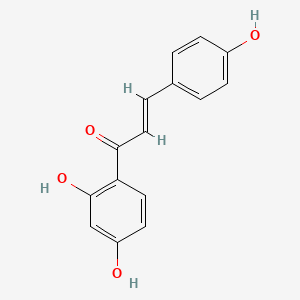| Yan F et al. |
Isoliquiritigenin suppresses human T Lymphocyte activation via covalently binding cysteine 46 of IκB kinase. |
2017 |
Oncotarget |
pmid:27626700
|
| Genthe JR et al. |
Ventromorphins: A New Class of Small Molecule Activators of the Canonical BMP Signaling Pathway. |
2017 |
ACS Chem. Biol. |
pmid:28787124
|
| Gao F et al. |
iRGD-modified lipid-polymer hybrid nanoparticles loaded with isoliquiritigenin to enhance anti-breast cancer effect and tumor-targeting ability. |
2017 |
Int J Nanomedicine |
pmid:28615942
|
| Hou C et al. |
Synthetic Isoliquiritigenin Inhibits Human Tongue Squamous Carcinoma Cells through Its Antioxidant Mechanism. |
2017 |
Oxid Med Cell Longev |
pmid:28203317
|
| Yu H et al. |
Effect of isoliquiritigenin for the treatment of atopic dermatitis-like skin lesions in mice. |
2017 |
Arch. Dermatol. Res. |
pmid:29026975
|
| Chen HY et al. |
Isoliquiritigenin Induces Autophagy and Inhibits Ovarian Cancer Cell Growth. |
2017 |
Int J Mol Sci |
pmid:28934130
|
| Bueno-Silva B et al. |
The effect of seasons on Brazilian red propolis and its botanical source: chemical composition and antibacterial activity. |
2017 |
Nat. Prod. Res. |
pmid:27701899
|
| Zeng J et al. |
Isoliquiritigenin alleviates early brain injury after experimental intracerebral hemorrhage via suppressing ROS- and/or NF-κB-mediated NLRP3 inflammasome activation by promoting Nrf2 antioxidant pathway. |
2017 |
J Neuroinflammation |
pmid:28610608
|
| Köksal Z et al. |
The inhibition effects of some natural products on lactoperoxidase purified from bovine milk. |
2017 |
J. Biochem. Mol. Toxicol. |
pmid:28594102
|
| Kim DH et al. |
Isoliquiritigenin inhibits the proliferation of human renal carcinoma Caki cells through the ROS-mediated regulation of the Jak2/STAT3 pathway. |
2017 |
Oncol. Rep. |
pmid:28560439
|
| Yang HH et al. |
Isoliquiritigenin Induces Cytotoxicity in PC-12 Cells In Vitro. |
2017 |
Appl. Biochem. Biotechnol. |
pmid:28488118
|
| Chen XY et al. |
Reprogramming induced by isoliquiritigenin diminishes melanoma cachexia through mTORC2-AKT-GSK3β signaling. |
2017 |
Oncotarget |
pmid:28410220
|
| Boyapelly K et al. |
Synthesis and Characterization of a Phosphate Prodrug of Isoliquiritigenin. |
2017 |
J. Nat. Prod. |
pmid:28252963
|
| Chi JH et al. |
Isoliquiritigenin inhibits TNF-α-induced release of high-mobility group box 1 through activation of HDAC in human intestinal epithelial HT-29 cells. |
2017 |
Eur. J. Pharmacol. |
pmid:28012970
|
| Wu M et al. |
Isoliquiritigenin decreases the incidence of colitis-associated colorectal cancer by modulating the intestinal microbiota. |
2016 |
Oncotarget |
pmid:27863401
|
| Wu CH et al. |
Isoliquiritigenin induces apoptosis and autophagy and inhibits endometrial cancer growth in mice. |
2016 |
Oncotarget |
pmid:27708238
|
| Jin XY et al. |
Isoliquiritigenin suppresses tumor necrosis factor-α-induced inflammation via peroxisome proliferator-activated receptor-γ in intestinal epithelial cells. |
2016 |
Arch. Pharm. Res. |
pmid:27539609
|
| Hsia SM et al. |
Isoliquiritigenin as a cause of DNA damage and inhibitor of ataxia-telangiectasia mutated expression leading to G2/M phase arrest and apoptosis in oral squamous cell carcinoma. |
2016 |
Head Neck |
pmid:25580586
|
| Yang EJ et al. |
The comparison of neuroprotective effects of isoliquiritigenin and its Phase I metabolites against glutamate-induced HT22 cell death. |
2016 |
Bioorg. Med. Chem. Lett. |
pmid:27815122
|
| Chen X et al. |
Differentiation-inducing and anti-proliferative activities of isoliquiritigenin and all-trans-retinoic acid on B16F0 melanoma cells: Mechanisms profiling by RNA-seq. |
2016 |
Gene |
pmid:27461947
|
